WHS General Risk Assessment for Cement Manufacturing Industry
VerifiedAdded on 2023/05/30
|16
|3570
|65
AI Summary
This report discusses the occupational health and safety concerns in the cement manufacturing industry, with a focus on risk assessment. It identifies key agencies, structures, and institutions that influence environmental health and suggests recommendations to resolve work safety risks identified.
Contribute Materials
Your contribution can guide someone’s learning journey. Share your
documents today.

Name of student:
Registration number:
Unit Title:
Unit Code:
Name of supervisor:
Date due:
WHS General Risk Assessment WHS2, V2.1, 1 November 2016 – Safety & Wellbeing Team
Hardcopies of this document are considered uncontrolled. Please refer to the Safety & Wellbeing website for the latest version.
1 | P a g e
Registration number:
Unit Title:
Unit Code:
Name of supervisor:
Date due:
WHS General Risk Assessment WHS2, V2.1, 1 November 2016 – Safety & Wellbeing Team
Hardcopies of this document are considered uncontrolled. Please refer to the Safety & Wellbeing website for the latest version.
1 | P a g e
Secure Best Marks with AI Grader
Need help grading? Try our AI Grader for instant feedback on your assignments.

Introduction
Occupational health and safety has become a public health concern and priority especially in developed and industrialized countries. OHS is a primary
concern in high risk industries especially the manufacturing and construction industries. Cement manufacturing industries is one of the high risk industries
where OHS has to be given a lot of priority. Since cement is widely and regularly used, it has been determined that there are many health hazards of cement
which includes lung function impairment, chronic obstructive lung diseases as well as stomach and colon problems (Ridley, 2015). The report uses work
safety risk assessment template and uses the six steps in filling the template. The report identifies key agencies, structures and institutions which influences
environmental health. The report summarizes the findings of the risk assessment and suggests recommendations to resolve work safety risks identified.
GENERAL RISK ASSESSMENT
Managing Workplace Health and Safety Risks procedure
Form WHS2
Workplace (School/Institute/Unit):
Useful links:
WHS Procedure: Managing Workplace Health and Safety Risks
Approved Code of Practice: How to Manage Work Health and Safety
Risks
Local Assessment No:
If applicable
Assessment
Date:
Next Review Date: /
/
Sign-off: (by a person with safety responsibility for the risk being assessed,
for example: Head of Research Group, Workshop Supervisor, Academic
WHS General Risk Assessment WHS2, V2.1, 1 November 2016 – Safety & Wellbeing Team
Hardcopies of this document are considered uncontrolled. Please refer to the Safety & Wellbeing website for the latest version.
2 | P a g e
Occupational health and safety has become a public health concern and priority especially in developed and industrialized countries. OHS is a primary
concern in high risk industries especially the manufacturing and construction industries. Cement manufacturing industries is one of the high risk industries
where OHS has to be given a lot of priority. Since cement is widely and regularly used, it has been determined that there are many health hazards of cement
which includes lung function impairment, chronic obstructive lung diseases as well as stomach and colon problems (Ridley, 2015). The report uses work
safety risk assessment template and uses the six steps in filling the template. The report identifies key agencies, structures and institutions which influences
environmental health. The report summarizes the findings of the risk assessment and suggests recommendations to resolve work safety risks identified.
GENERAL RISK ASSESSMENT
Managing Workplace Health and Safety Risks procedure
Form WHS2
Workplace (School/Institute/Unit):
Useful links:
WHS Procedure: Managing Workplace Health and Safety Risks
Approved Code of Practice: How to Manage Work Health and Safety
Risks
Local Assessment No:
If applicable
Assessment
Date:
Next Review Date: /
/
Sign-off: (by a person with safety responsibility for the risk being assessed,
for example: Head of Research Group, Workshop Supervisor, Academic
WHS General Risk Assessment WHS2, V2.1, 1 November 2016 – Safety & Wellbeing Team
Hardcopies of this document are considered uncontrolled. Please refer to the Safety & Wellbeing website for the latest version.
2 | P a g e
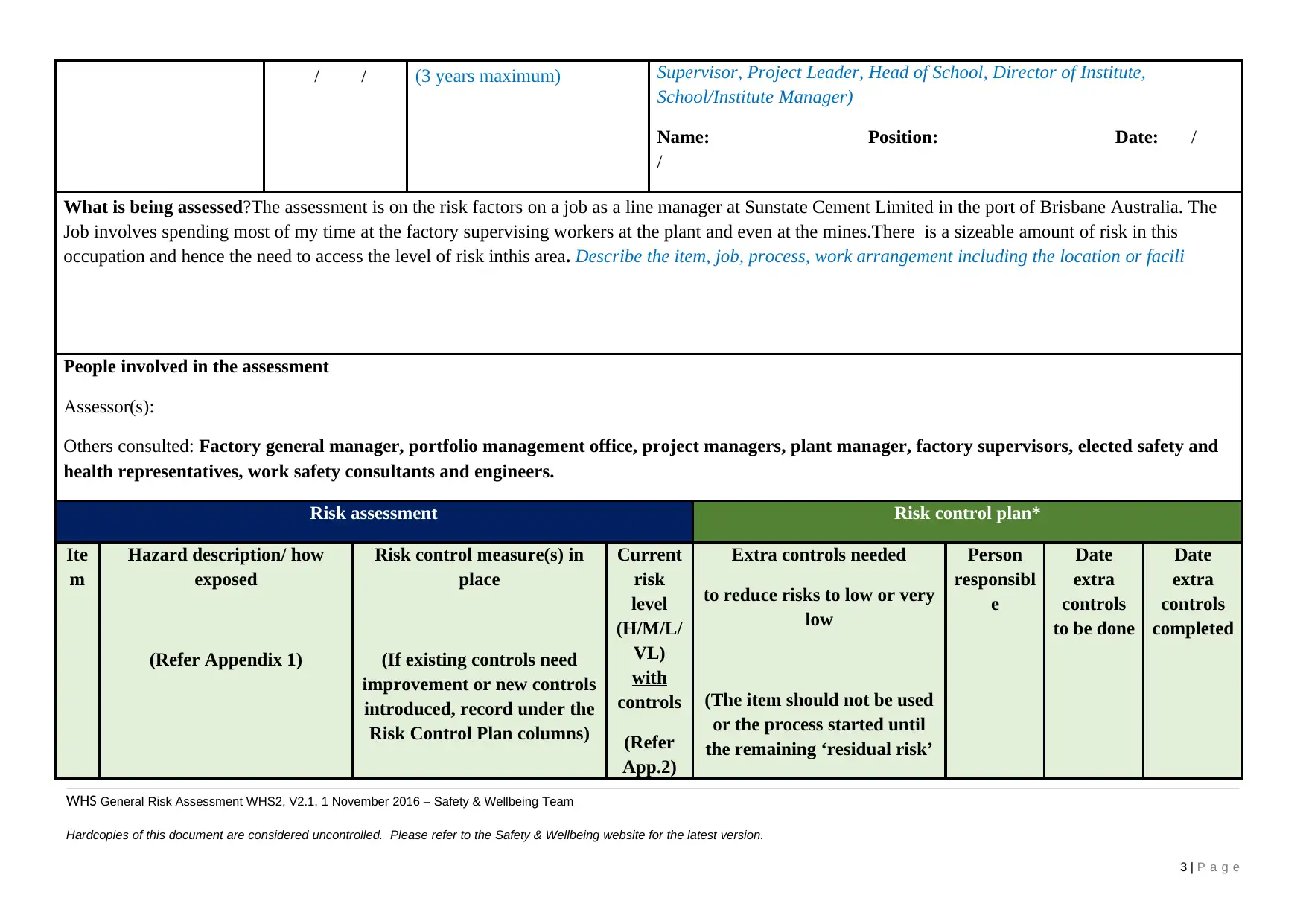
/ / (3 years maximum) Supervisor, Project Leader, Head of School, Director of Institute,
School/Institute Manager)
Name: Position: Date: /
/
What is being assessed?The assessment is on the risk factors on a job as a line manager at Sunstate Cement Limited in the port of Brisbane Australia. The
Job involves spending most of my time at the factory supervising workers at the plant and even at the mines.There is a sizeable amount of risk in this
occupation and hence the need to access the level of risk inthis area. Describe the item, job, process, work arrangement including the location or facili
People involved in the assessment
Assessor(s):
Others consulted: Factory general manager, portfolio management office, project managers, plant manager, factory supervisors, elected safety and
health representatives, work safety consultants and engineers.
Risk assessment Risk control plan*
Ite
m
Hazard description/ how
exposed
(Refer Appendix 1)
Risk control measure(s) in
place
(If existing controls need
improvement or new controls
introduced, record under the
Risk Control Plan columns)
Current
risk
level
(H/M/L/
VL)
with
controls
(Refer
App.2)
Extra controls needed
to reduce risks to low or very
low
(The item should not be used
or the process started until
the remaining ‘residual risk’
Person
responsibl
e
Date
extra
controls
to be done
Date
extra
controls
completed
WHS General Risk Assessment WHS2, V2.1, 1 November 2016 – Safety & Wellbeing Team
Hardcopies of this document are considered uncontrolled. Please refer to the Safety & Wellbeing website for the latest version.
3 | P a g e
School/Institute Manager)
Name: Position: Date: /
/
What is being assessed?The assessment is on the risk factors on a job as a line manager at Sunstate Cement Limited in the port of Brisbane Australia. The
Job involves spending most of my time at the factory supervising workers at the plant and even at the mines.There is a sizeable amount of risk in this
occupation and hence the need to access the level of risk inthis area. Describe the item, job, process, work arrangement including the location or facili
People involved in the assessment
Assessor(s):
Others consulted: Factory general manager, portfolio management office, project managers, plant manager, factory supervisors, elected safety and
health representatives, work safety consultants and engineers.
Risk assessment Risk control plan*
Ite
m
Hazard description/ how
exposed
(Refer Appendix 1)
Risk control measure(s) in
place
(If existing controls need
improvement or new controls
introduced, record under the
Risk Control Plan columns)
Current
risk
level
(H/M/L/
VL)
with
controls
(Refer
App.2)
Extra controls needed
to reduce risks to low or very
low
(The item should not be used
or the process started until
the remaining ‘residual risk’
Person
responsibl
e
Date
extra
controls
to be done
Date
extra
controls
completed
WHS General Risk Assessment WHS2, V2.1, 1 November 2016 – Safety & Wellbeing Team
Hardcopies of this document are considered uncontrolled. Please refer to the Safety & Wellbeing website for the latest version.
3 | P a g e
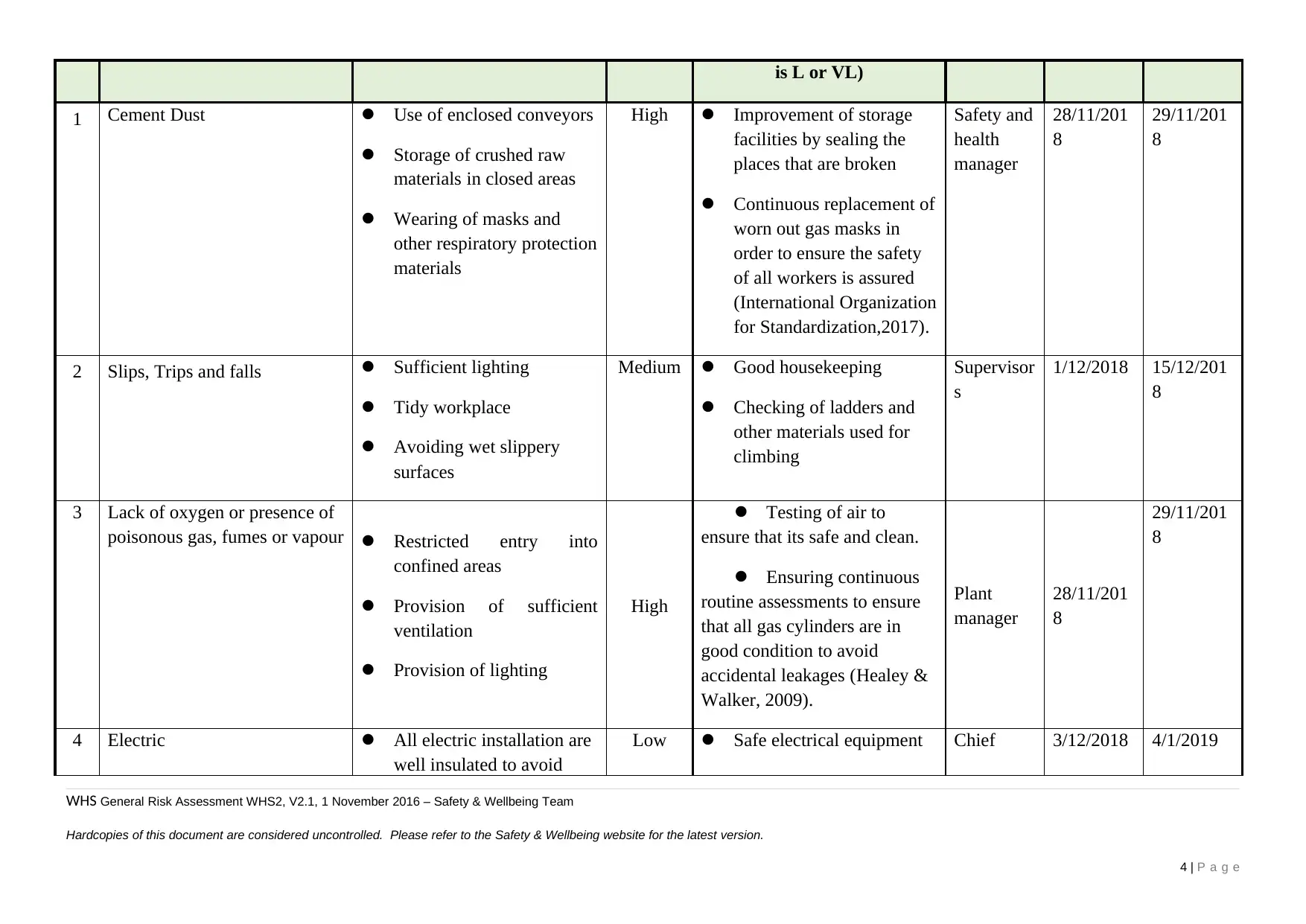
is L or VL)
1 Cement Dust Use of enclosed conveyors
Storage of crushed raw
materials in closed areas
Wearing of masks and
other respiratory protection
materials
High Improvement of storage
facilities by sealing the
places that are broken
Continuous replacement of
worn out gas masks in
order to ensure the safety
of all workers is assured
(International Organization
for Standardization,2017).
Safety and
health
manager
28/11/201
8
29/11/201
8
2 Slips, Trips and falls Sufficient lighting
Tidy workplace
Avoiding wet slippery
surfaces
Medium Good housekeeping
Checking of ladders and
other materials used for
climbing
Supervisor
s
1/12/2018 15/12/201
8
3 Lack of oxygen or presence of
poisonous gas, fumes or vapour Restricted entry into
confined areas
Provision of sufficient
ventilation
Provision of lighting
High
Testing of air to
ensure that its safe and clean.
Ensuring continuous
routine assessments to ensure
that all gas cylinders are in
good condition to avoid
accidental leakages (Healey &
Walker, 2009).
Plant
manager
28/11/201
8
29/11/201
8
4 Electric All electric installation are
well insulated to avoid
Low Safe electrical equipment Chief 3/12/2018 4/1/2019
WHS General Risk Assessment WHS2, V2.1, 1 November 2016 – Safety & Wellbeing Team
Hardcopies of this document are considered uncontrolled. Please refer to the Safety & Wellbeing website for the latest version.
4 | P a g e
1 Cement Dust Use of enclosed conveyors
Storage of crushed raw
materials in closed areas
Wearing of masks and
other respiratory protection
materials
High Improvement of storage
facilities by sealing the
places that are broken
Continuous replacement of
worn out gas masks in
order to ensure the safety
of all workers is assured
(International Organization
for Standardization,2017).
Safety and
health
manager
28/11/201
8
29/11/201
8
2 Slips, Trips and falls Sufficient lighting
Tidy workplace
Avoiding wet slippery
surfaces
Medium Good housekeeping
Checking of ladders and
other materials used for
climbing
Supervisor
s
1/12/2018 15/12/201
8
3 Lack of oxygen or presence of
poisonous gas, fumes or vapour Restricted entry into
confined areas
Provision of sufficient
ventilation
Provision of lighting
High
Testing of air to
ensure that its safe and clean.
Ensuring continuous
routine assessments to ensure
that all gas cylinders are in
good condition to avoid
accidental leakages (Healey &
Walker, 2009).
Plant
manager
28/11/201
8
29/11/201
8
4 Electric All electric installation are
well insulated to avoid
Low Safe electrical equipment Chief 3/12/2018 4/1/2019
WHS General Risk Assessment WHS2, V2.1, 1 November 2016 – Safety & Wellbeing Team
Hardcopies of this document are considered uncontrolled. Please refer to the Safety & Wellbeing website for the latest version.
4 | P a g e
Secure Best Marks with AI Grader
Need help grading? Try our AI Grader for instant feedback on your assignments.
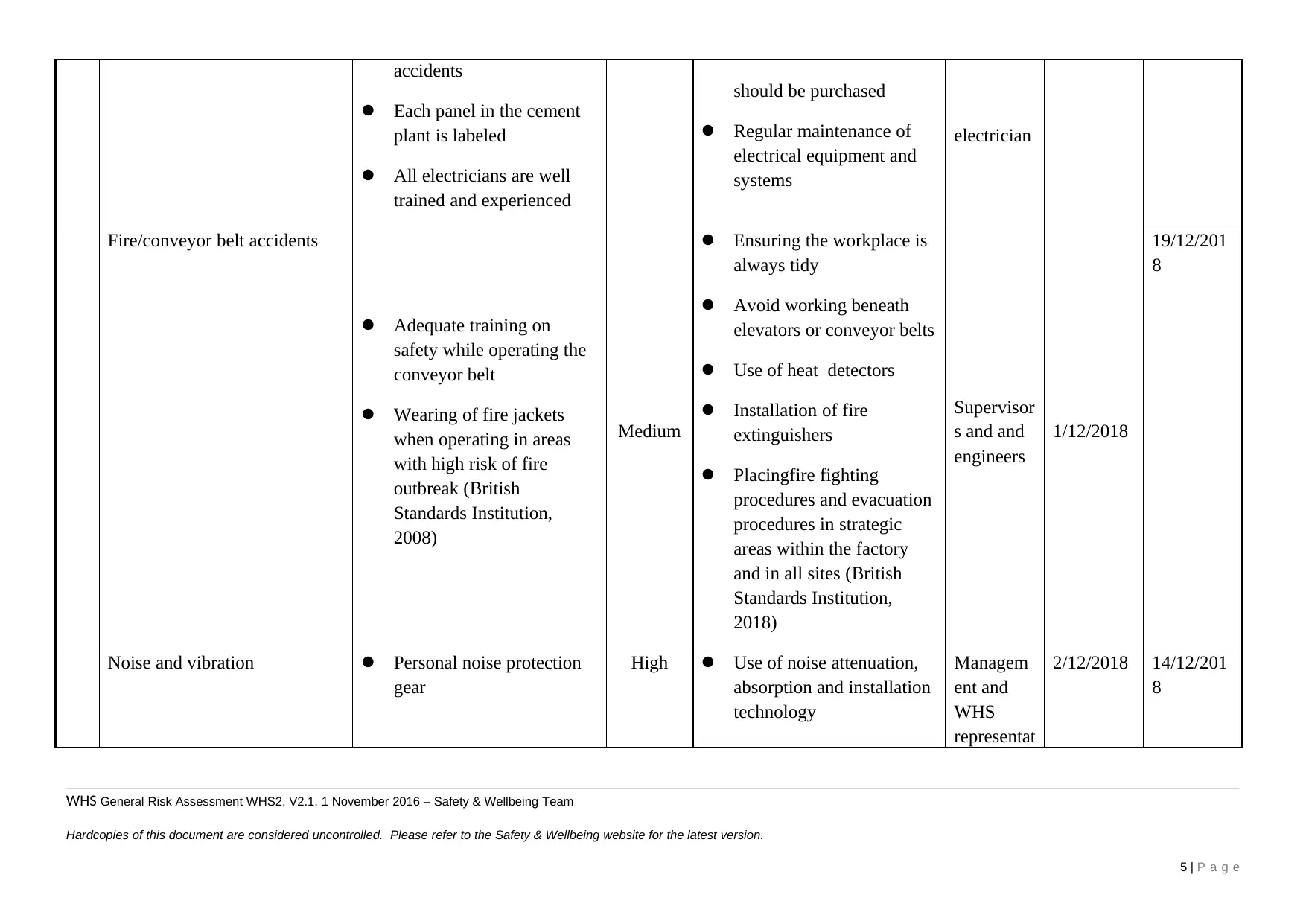
accidents
Each panel in the cement
plant is labeled
All electricians are well
trained and experienced
should be purchased
Regular maintenance of
electrical equipment and
systems
electrician
Fire/conveyor belt accidents
Adequate training on
safety while operating the
conveyor belt
Wearing of fire jackets
when operating in areas
with high risk of fire
outbreak (British
Standards Institution,
2008)
Medium
Ensuring the workplace is
always tidy
Avoid working beneath
elevators or conveyor belts
Use of heat detectors
Installation of fire
extinguishers
Placingfire fighting
procedures and evacuation
procedures in strategic
areas within the factory
and in all sites (British
Standards Institution,
2018)
Supervisor
s and and
engineers
1/12/2018
19/12/201
8
Noise and vibration Personal noise protection
gear
High Use of noise attenuation,
absorption and installation
technology
Managem
ent and
WHS
representat
2/12/2018 14/12/201
8
WHS General Risk Assessment WHS2, V2.1, 1 November 2016 – Safety & Wellbeing Team
Hardcopies of this document are considered uncontrolled. Please refer to the Safety & Wellbeing website for the latest version.
5 | P a g e
Each panel in the cement
plant is labeled
All electricians are well
trained and experienced
should be purchased
Regular maintenance of
electrical equipment and
systems
electrician
Fire/conveyor belt accidents
Adequate training on
safety while operating the
conveyor belt
Wearing of fire jackets
when operating in areas
with high risk of fire
outbreak (British
Standards Institution,
2008)
Medium
Ensuring the workplace is
always tidy
Avoid working beneath
elevators or conveyor belts
Use of heat detectors
Installation of fire
extinguishers
Placingfire fighting
procedures and evacuation
procedures in strategic
areas within the factory
and in all sites (British
Standards Institution,
2018)
Supervisor
s and and
engineers
1/12/2018
19/12/201
8
Noise and vibration Personal noise protection
gear
High Use of noise attenuation,
absorption and installation
technology
Managem
ent and
WHS
representat
2/12/2018 14/12/201
8
WHS General Risk Assessment WHS2, V2.1, 1 November 2016 – Safety & Wellbeing Team
Hardcopies of this document are considered uncontrolled. Please refer to the Safety & Wellbeing website for the latest version.
5 | P a g e
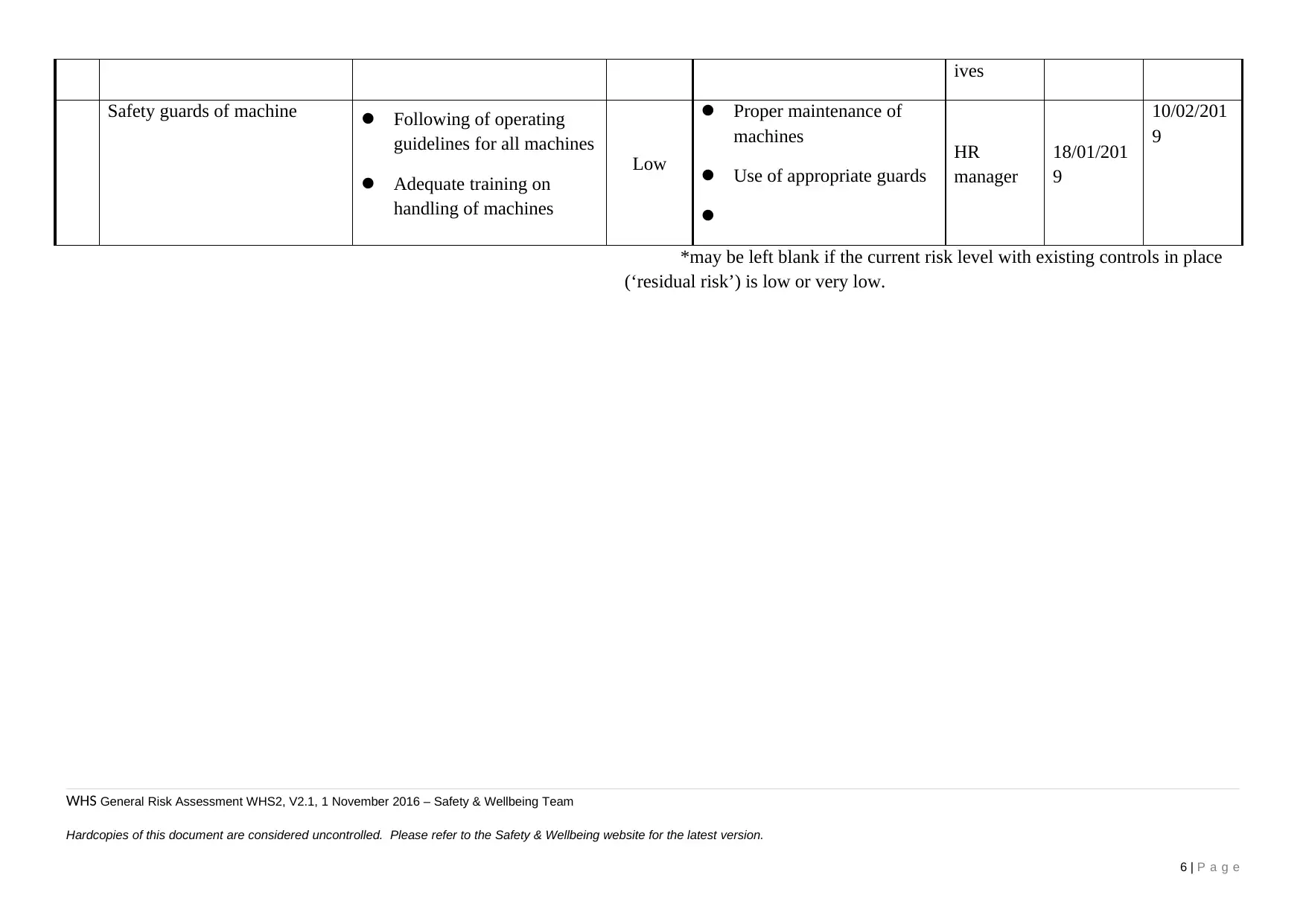
ives
Safety guards of machine Following of operating
guidelines for all machines
Adequate training on
handling of machines
Low
Proper maintenance of
machines
Use of appropriate guards
HR
manager
18/01/201
9
10/02/201
9
*may be left blank if the current risk level with existing controls in place
(‘residual risk’) is low or very low.
WHS General Risk Assessment WHS2, V2.1, 1 November 2016 – Safety & Wellbeing Team
Hardcopies of this document are considered uncontrolled. Please refer to the Safety & Wellbeing website for the latest version.
6 | P a g e
Safety guards of machine Following of operating
guidelines for all machines
Adequate training on
handling of machines
Low
Proper maintenance of
machines
Use of appropriate guards
HR
manager
18/01/201
9
10/02/201
9
*may be left blank if the current risk level with existing controls in place
(‘residual risk’) is low or very low.
WHS General Risk Assessment WHS2, V2.1, 1 November 2016 – Safety & Wellbeing Team
Hardcopies of this document are considered uncontrolled. Please refer to the Safety & Wellbeing website for the latest version.
6 | P a g e
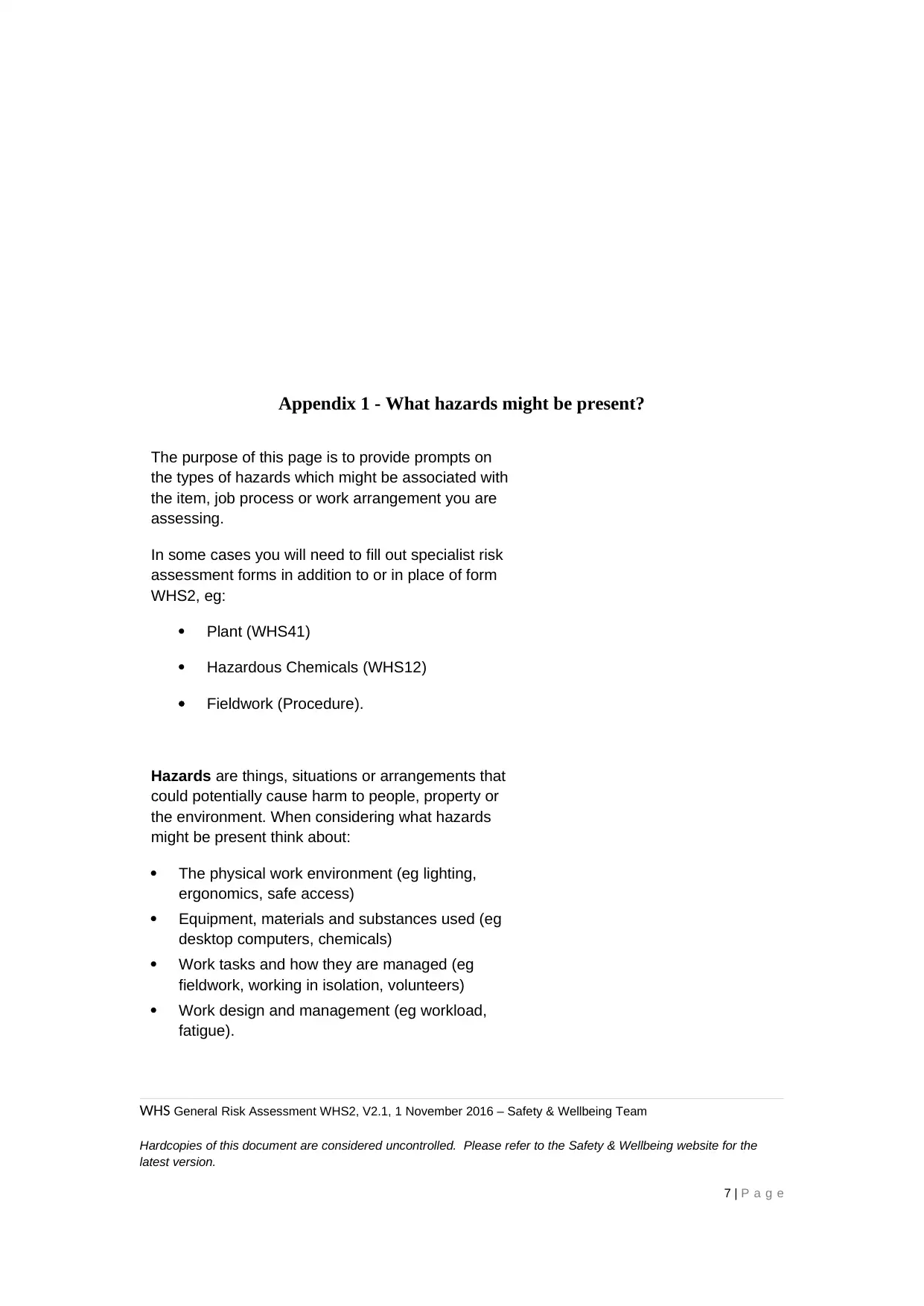
Appendix 1 - What hazards might be present?
WHS General Risk Assessment WHS2, V2.1, 1 November 2016 – Safety & Wellbeing Team
Hardcopies of this document are considered uncontrolled. Please refer to the Safety & Wellbeing website for the
latest version.
7 | P a g e
The purpose of this page is to provide prompts on
the types of hazards which might be associated with
the item, job process or work arrangement you are
assessing.
In some cases you will need to fill out specialist risk
assessment forms in addition to or in place of form
WHS2, eg:
Plant (WHS41)
Hazardous Chemicals (WHS12)
Fieldwork (Procedure).
Hazards are things, situations or arrangements that
could potentially cause harm to people, property or
the environment. When considering what hazards
might be present think about:
The physical work environment (eg lighting,
ergonomics, safe access)
Equipment, materials and substances used (eg
desktop computers, chemicals)
Work tasks and how they are managed (eg
fieldwork, working in isolation, volunteers)
Work design and management (eg workload,
fatigue).
WHS General Risk Assessment WHS2, V2.1, 1 November 2016 – Safety & Wellbeing Team
Hardcopies of this document are considered uncontrolled. Please refer to the Safety & Wellbeing website for the
latest version.
7 | P a g e
The purpose of this page is to provide prompts on
the types of hazards which might be associated with
the item, job process or work arrangement you are
assessing.
In some cases you will need to fill out specialist risk
assessment forms in addition to or in place of form
WHS2, eg:
Plant (WHS41)
Hazardous Chemicals (WHS12)
Fieldwork (Procedure).
Hazards are things, situations or arrangements that
could potentially cause harm to people, property or
the environment. When considering what hazards
might be present think about:
The physical work environment (eg lighting,
ergonomics, safe access)
Equipment, materials and substances used (eg
desktop computers, chemicals)
Work tasks and how they are managed (eg
fieldwork, working in isolation, volunteers)
Work design and management (eg workload,
fatigue).
Paraphrase This Document
Need a fresh take? Get an instant paraphrase of this document with our AI Paraphraser
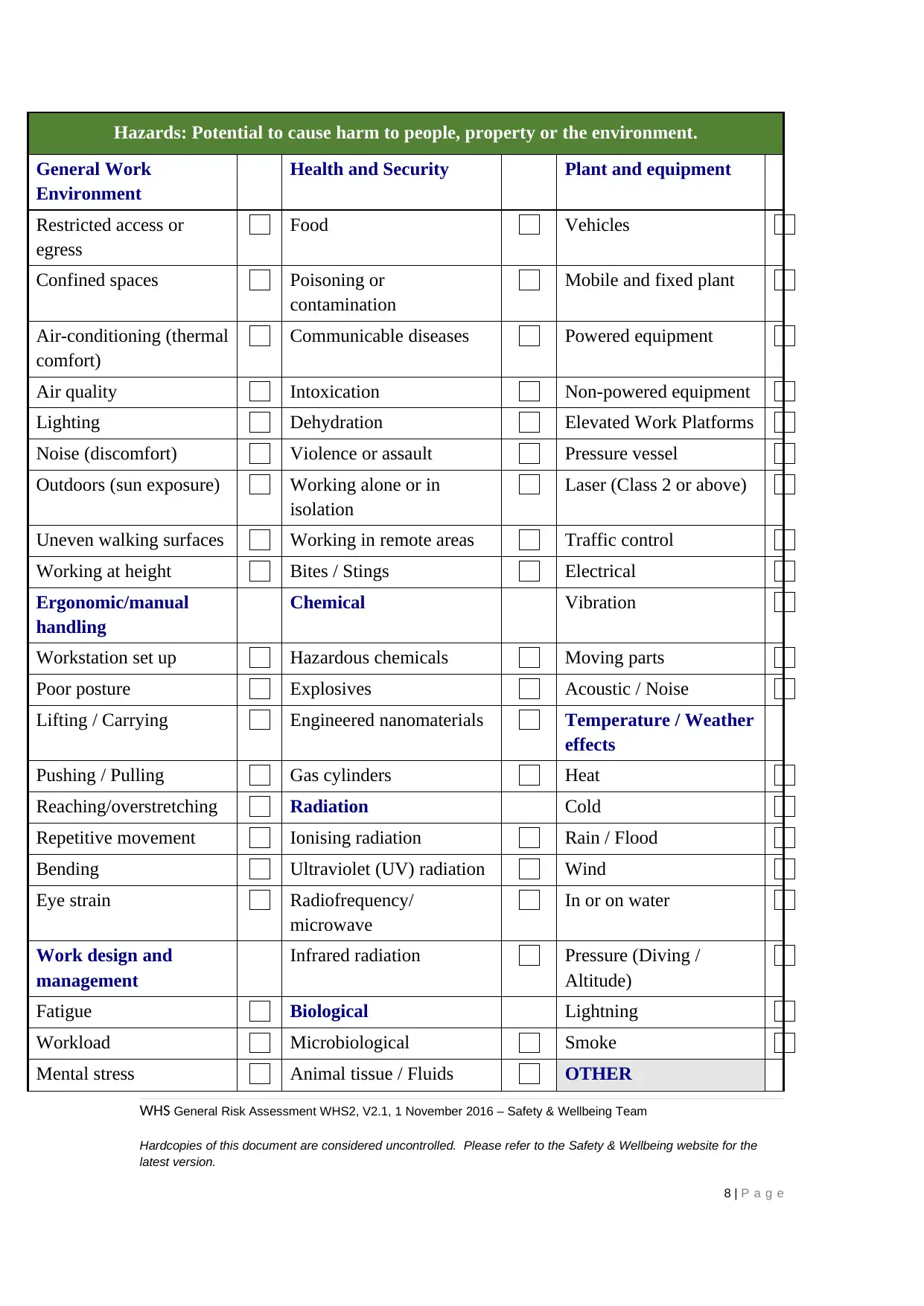
Hazards: Potential to cause harm to people, property or the environment.
General Work
Environment
Health and Security Plant and equipment
Restricted access or
egress
Food Vehicles
Confined spaces Poisoning or
contamination
Mobile and fixed plant
Air-conditioning (thermal
comfort)
Communicable diseases Powered equipment
Air quality Intoxication Non-powered equipment
Lighting Dehydration Elevated Work Platforms
Noise (discomfort) Violence or assault Pressure vessel
Outdoors (sun exposure) Working alone or in
isolation
Laser (Class 2 or above)
Uneven walking surfaces Working in remote areas Traffic control
Working at height Bites / Stings Electrical
Ergonomic/manual
handling
Chemical Vibration
Workstation set up Hazardous chemicals Moving parts
Poor posture Explosives Acoustic / Noise
Lifting / Carrying Engineered nanomaterials Temperature / Weather
effects
Pushing / Pulling Gas cylinders Heat
Reaching/overstretching Radiation Cold
Repetitive movement Ionising radiation Rain / Flood
Bending Ultraviolet (UV) radiation Wind
Eye strain Radiofrequency/
microwave
In or on water
Work design and
management
Infrared radiation Pressure (Diving /
Altitude)
Fatigue Biological Lightning
Workload Microbiological Smoke
Mental stress Animal tissue / Fluids OTHER
WHS General Risk Assessment WHS2, V2.1, 1 November 2016 – Safety & Wellbeing Team
Hardcopies of this document are considered uncontrolled. Please refer to the Safety & Wellbeing website for the
latest version.
8 | P a g e
General Work
Environment
Health and Security Plant and equipment
Restricted access or
egress
Food Vehicles
Confined spaces Poisoning or
contamination
Mobile and fixed plant
Air-conditioning (thermal
comfort)
Communicable diseases Powered equipment
Air quality Intoxication Non-powered equipment
Lighting Dehydration Elevated Work Platforms
Noise (discomfort) Violence or assault Pressure vessel
Outdoors (sun exposure) Working alone or in
isolation
Laser (Class 2 or above)
Uneven walking surfaces Working in remote areas Traffic control
Working at height Bites / Stings Electrical
Ergonomic/manual
handling
Chemical Vibration
Workstation set up Hazardous chemicals Moving parts
Poor posture Explosives Acoustic / Noise
Lifting / Carrying Engineered nanomaterials Temperature / Weather
effects
Pushing / Pulling Gas cylinders Heat
Reaching/overstretching Radiation Cold
Repetitive movement Ionising radiation Rain / Flood
Bending Ultraviolet (UV) radiation Wind
Eye strain Radiofrequency/
microwave
In or on water
Work design and
management
Infrared radiation Pressure (Diving /
Altitude)
Fatigue Biological Lightning
Workload Microbiological Smoke
Mental stress Animal tissue / Fluids OTHER
WHS General Risk Assessment WHS2, V2.1, 1 November 2016 – Safety & Wellbeing Team
Hardcopies of this document are considered uncontrolled. Please refer to the Safety & Wellbeing website for the
latest version.
8 | P a g e
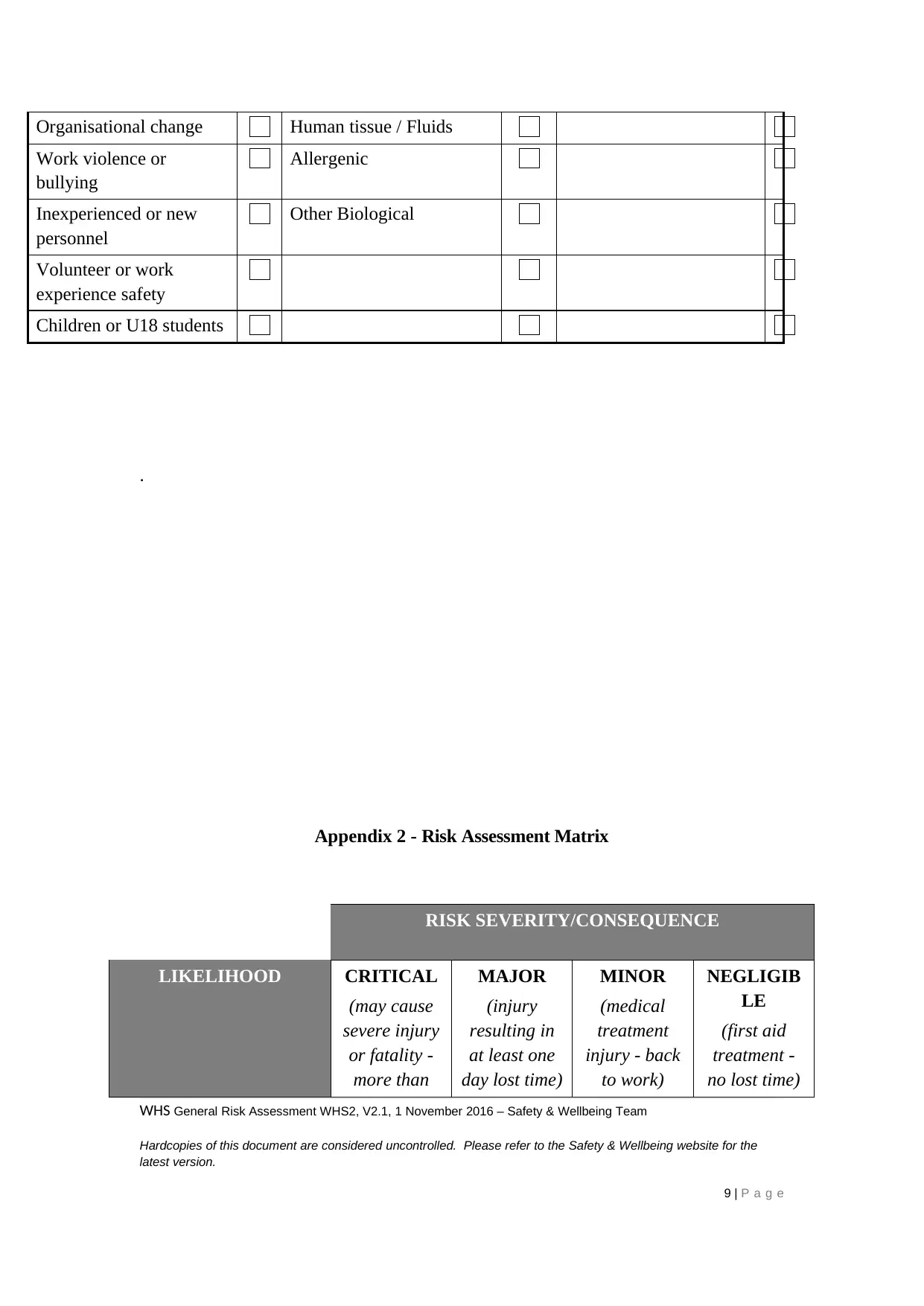
Organisational change Human tissue / Fluids
Work violence or
bullying
Allergenic
Inexperienced or new
personnel
Other Biological
Volunteer or work
experience safety
Children or U18 students
.
Appendix 2 - Risk Assessment Matrix
RISK SEVERITY/CONSEQUENCE
LIKELIHOOD CRITICAL
(may cause
severe injury
or fatality -
more than
MAJOR
(injury
resulting in
at least one
day lost time)
MINOR
(medical
treatment
injury - back
to work)
NEGLIGIB
LE
(first aid
treatment -
no lost time)
WHS General Risk Assessment WHS2, V2.1, 1 November 2016 – Safety & Wellbeing Team
Hardcopies of this document are considered uncontrolled. Please refer to the Safety & Wellbeing website for the
latest version.
9 | P a g e
Work violence or
bullying
Allergenic
Inexperienced or new
personnel
Other Biological
Volunteer or work
experience safety
Children or U18 students
.
Appendix 2 - Risk Assessment Matrix
RISK SEVERITY/CONSEQUENCE
LIKELIHOOD CRITICAL
(may cause
severe injury
or fatality -
more than
MAJOR
(injury
resulting in
at least one
day lost time)
MINOR
(medical
treatment
injury - back
to work)
NEGLIGIB
LE
(first aid
treatment -
no lost time)
WHS General Risk Assessment WHS2, V2.1, 1 November 2016 – Safety & Wellbeing Team
Hardcopies of this document are considered uncontrolled. Please refer to the Safety & Wellbeing website for the
latest version.
9 | P a g e
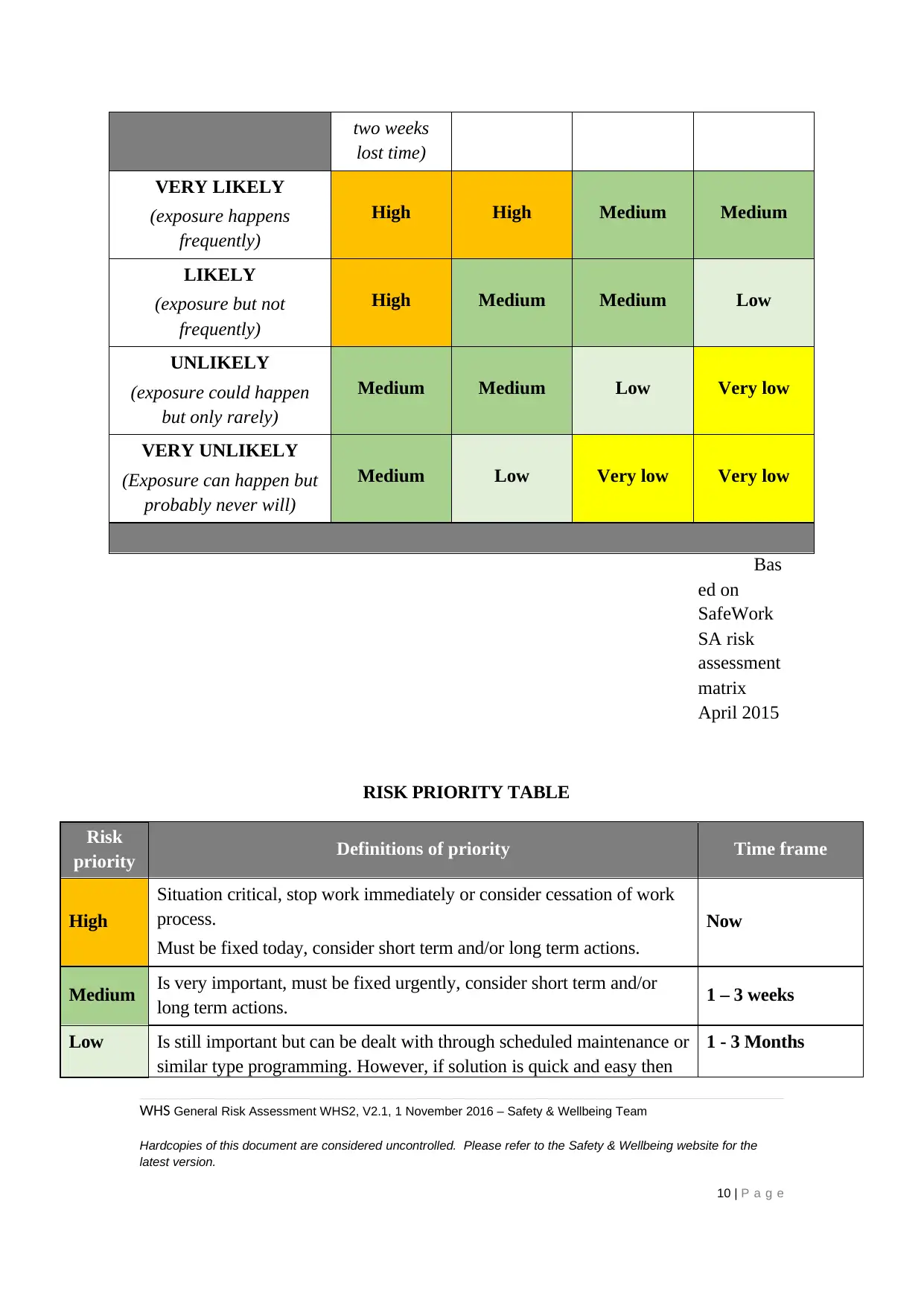
two weeks
lost time)
VERY LIKELY
(exposure happens
frequently)
High High Medium Medium
LIKELY
(exposure but not
frequently)
High Medium Medium Low
UNLIKELY
(exposure could happen
but only rarely)
Medium Medium Low Very low
VERY UNLIKELY
(Exposure can happen but
probably never will)
Medium Low Very low Very low
Bas
ed on
SafeWork
SA risk
assessment
matrix
April 2015
RISK PRIORITY TABLE
Risk
priority Definitions of priority Time frame
High
Situation critical, stop work immediately or consider cessation of work
process.
Must be fixed today, consider short term and/or long term actions.
Now
Medium Is very important, must be fixed urgently, consider short term and/or
long term actions. 1 – 3 weeks
Low Is still important but can be dealt with through scheduled maintenance or
similar type programming. However, if solution is quick and easy then
1 - 3 Months
WHS General Risk Assessment WHS2, V2.1, 1 November 2016 – Safety & Wellbeing Team
Hardcopies of this document are considered uncontrolled. Please refer to the Safety & Wellbeing website for the
latest version.
10 | P a g e
lost time)
VERY LIKELY
(exposure happens
frequently)
High High Medium Medium
LIKELY
(exposure but not
frequently)
High Medium Medium Low
UNLIKELY
(exposure could happen
but only rarely)
Medium Medium Low Very low
VERY UNLIKELY
(Exposure can happen but
probably never will)
Medium Low Very low Very low
Bas
ed on
SafeWork
SA risk
assessment
matrix
April 2015
RISK PRIORITY TABLE
Risk
priority Definitions of priority Time frame
High
Situation critical, stop work immediately or consider cessation of work
process.
Must be fixed today, consider short term and/or long term actions.
Now
Medium Is very important, must be fixed urgently, consider short term and/or
long term actions. 1 – 3 weeks
Low Is still important but can be dealt with through scheduled maintenance or
similar type programming. However, if solution is quick and easy then
1 - 3 Months
WHS General Risk Assessment WHS2, V2.1, 1 November 2016 – Safety & Wellbeing Team
Hardcopies of this document are considered uncontrolled. Please refer to the Safety & Wellbeing website for the
latest version.
10 | P a g e
Secure Best Marks with AI Grader
Need help grading? Try our AI Grader for instant feedback on your assignments.
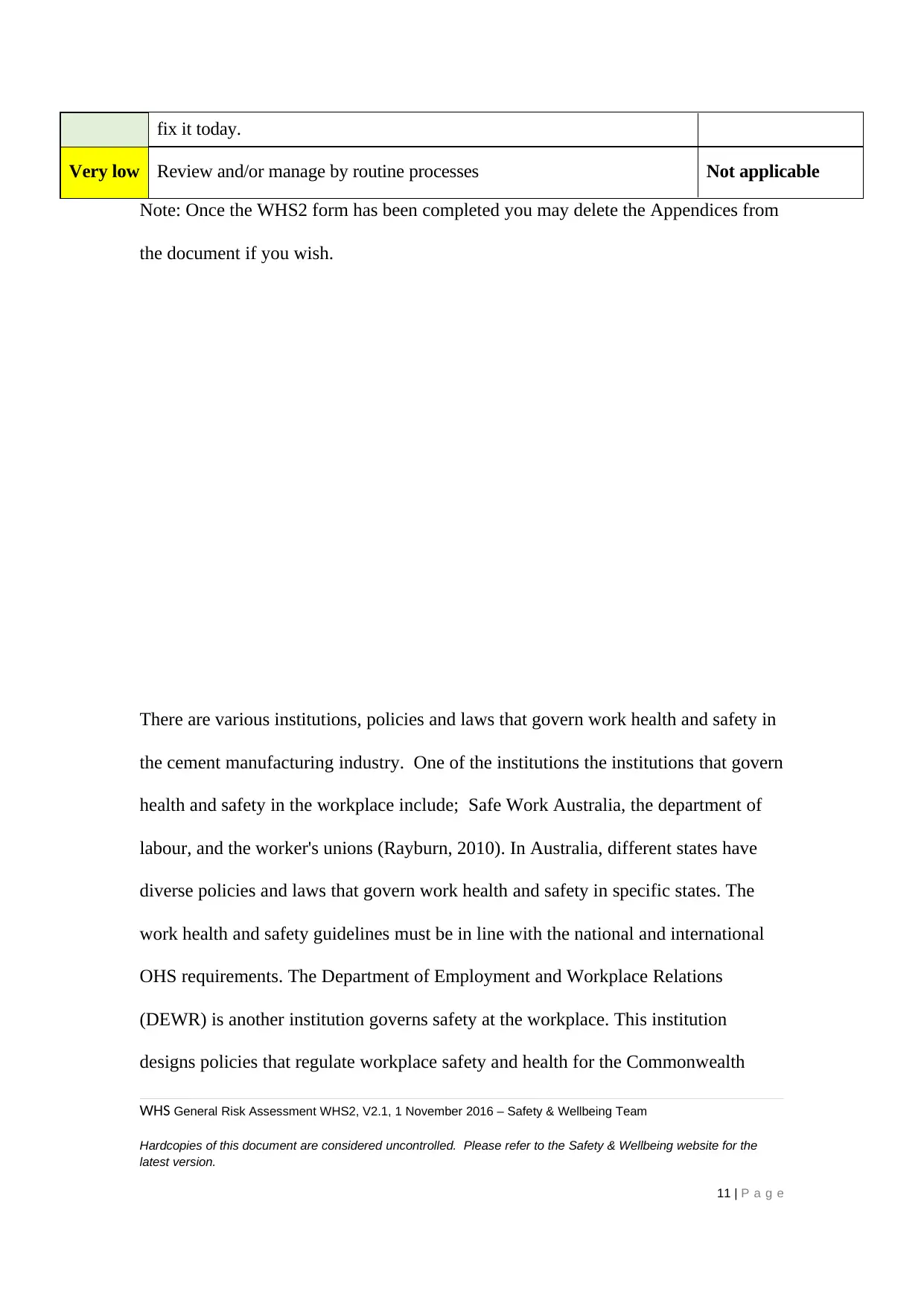
fix it today.
Very low Review and/or manage by routine processes Not applicable
Note: Once the WHS2 form has been completed you may delete the Appendices from
the document if you wish.
There are various institutions, policies and laws that govern work health and safety in
the cement manufacturing industry. One of the institutions the institutions that govern
health and safety in the workplace include; Safe Work Australia, the department of
labour, and the worker's unions (Rayburn, 2010). In Australia, different states have
diverse policies and laws that govern work health and safety in specific states. The
work health and safety guidelines must be in line with the national and international
OHS requirements. The Department of Employment and Workplace Relations
(DEWR) is another institution governs safety at the workplace. This institution
designs policies that regulate workplace safety and health for the Commonwealth
WHS General Risk Assessment WHS2, V2.1, 1 November 2016 – Safety & Wellbeing Team
Hardcopies of this document are considered uncontrolled. Please refer to the Safety & Wellbeing website for the
latest version.
11 | P a g e
Very low Review and/or manage by routine processes Not applicable
Note: Once the WHS2 form has been completed you may delete the Appendices from
the document if you wish.
There are various institutions, policies and laws that govern work health and safety in
the cement manufacturing industry. One of the institutions the institutions that govern
health and safety in the workplace include; Safe Work Australia, the department of
labour, and the worker's unions (Rayburn, 2010). In Australia, different states have
diverse policies and laws that govern work health and safety in specific states. The
work health and safety guidelines must be in line with the national and international
OHS requirements. The Department of Employment and Workplace Relations
(DEWR) is another institution governs safety at the workplace. This institution
designs policies that regulate workplace safety and health for the Commonwealth
WHS General Risk Assessment WHS2, V2.1, 1 November 2016 – Safety & Wellbeing Team
Hardcopies of this document are considered uncontrolled. Please refer to the Safety & Wellbeing website for the
latest version.
11 | P a g e
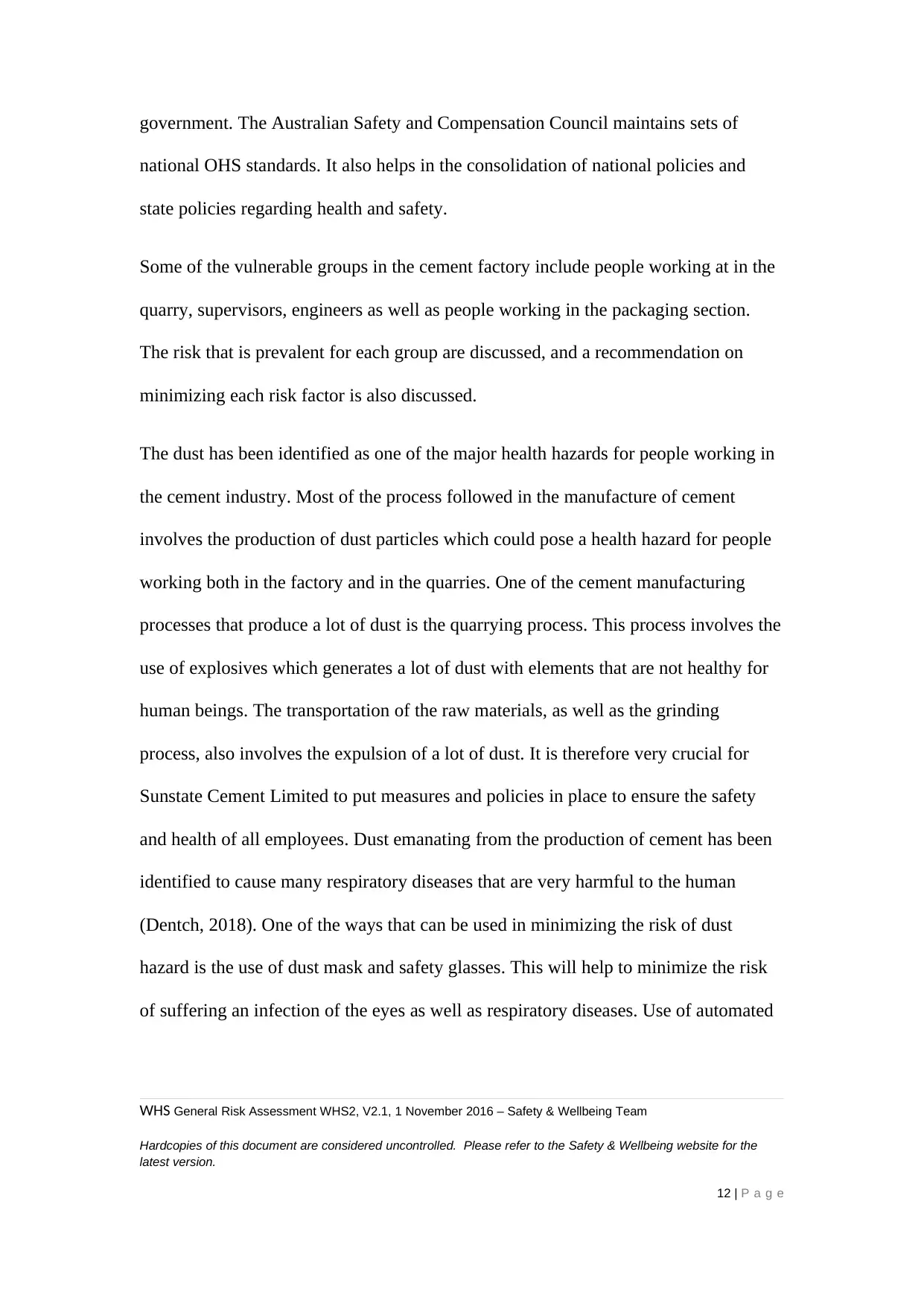
government. The Australian Safety and Compensation Council maintains sets of
national OHS standards. It also helps in the consolidation of national policies and
state policies regarding health and safety.
Some of the vulnerable groups in the cement factory include people working at in the
quarry, supervisors, engineers as well as people working in the packaging section.
The risk that is prevalent for each group are discussed, and a recommendation on
minimizing each risk factor is also discussed.
The dust has been identified as one of the major health hazards for people working in
the cement industry. Most of the process followed in the manufacture of cement
involves the production of dust particles which could pose a health hazard for people
working both in the factory and in the quarries. One of the cement manufacturing
processes that produce a lot of dust is the quarrying process. This process involves the
use of explosives which generates a lot of dust with elements that are not healthy for
human beings. The transportation of the raw materials, as well as the grinding
process, also involves the expulsion of a lot of dust. It is therefore very crucial for
Sunstate Cement Limited to put measures and policies in place to ensure the safety
and health of all employees. Dust emanating from the production of cement has been
identified to cause many respiratory diseases that are very harmful to the human
(Dentch, 2018). One of the ways that can be used in minimizing the risk of dust
hazard is the use of dust mask and safety glasses. This will help to minimize the risk
of suffering an infection of the eyes as well as respiratory diseases. Use of automated
WHS General Risk Assessment WHS2, V2.1, 1 November 2016 – Safety & Wellbeing Team
Hardcopies of this document are considered uncontrolled. Please refer to the Safety & Wellbeing website for the
latest version.
12 | P a g e
national OHS standards. It also helps in the consolidation of national policies and
state policies regarding health and safety.
Some of the vulnerable groups in the cement factory include people working at in the
quarry, supervisors, engineers as well as people working in the packaging section.
The risk that is prevalent for each group are discussed, and a recommendation on
minimizing each risk factor is also discussed.
The dust has been identified as one of the major health hazards for people working in
the cement industry. Most of the process followed in the manufacture of cement
involves the production of dust particles which could pose a health hazard for people
working both in the factory and in the quarries. One of the cement manufacturing
processes that produce a lot of dust is the quarrying process. This process involves the
use of explosives which generates a lot of dust with elements that are not healthy for
human beings. The transportation of the raw materials, as well as the grinding
process, also involves the expulsion of a lot of dust. It is therefore very crucial for
Sunstate Cement Limited to put measures and policies in place to ensure the safety
and health of all employees. Dust emanating from the production of cement has been
identified to cause many respiratory diseases that are very harmful to the human
(Dentch, 2018). One of the ways that can be used in minimizing the risk of dust
hazard is the use of dust mask and safety glasses. This will help to minimize the risk
of suffering an infection of the eyes as well as respiratory diseases. Use of automated
WHS General Risk Assessment WHS2, V2.1, 1 November 2016 – Safety & Wellbeing Team
Hardcopies of this document are considered uncontrolled. Please refer to the Safety & Wellbeing website for the
latest version.
12 | P a g e
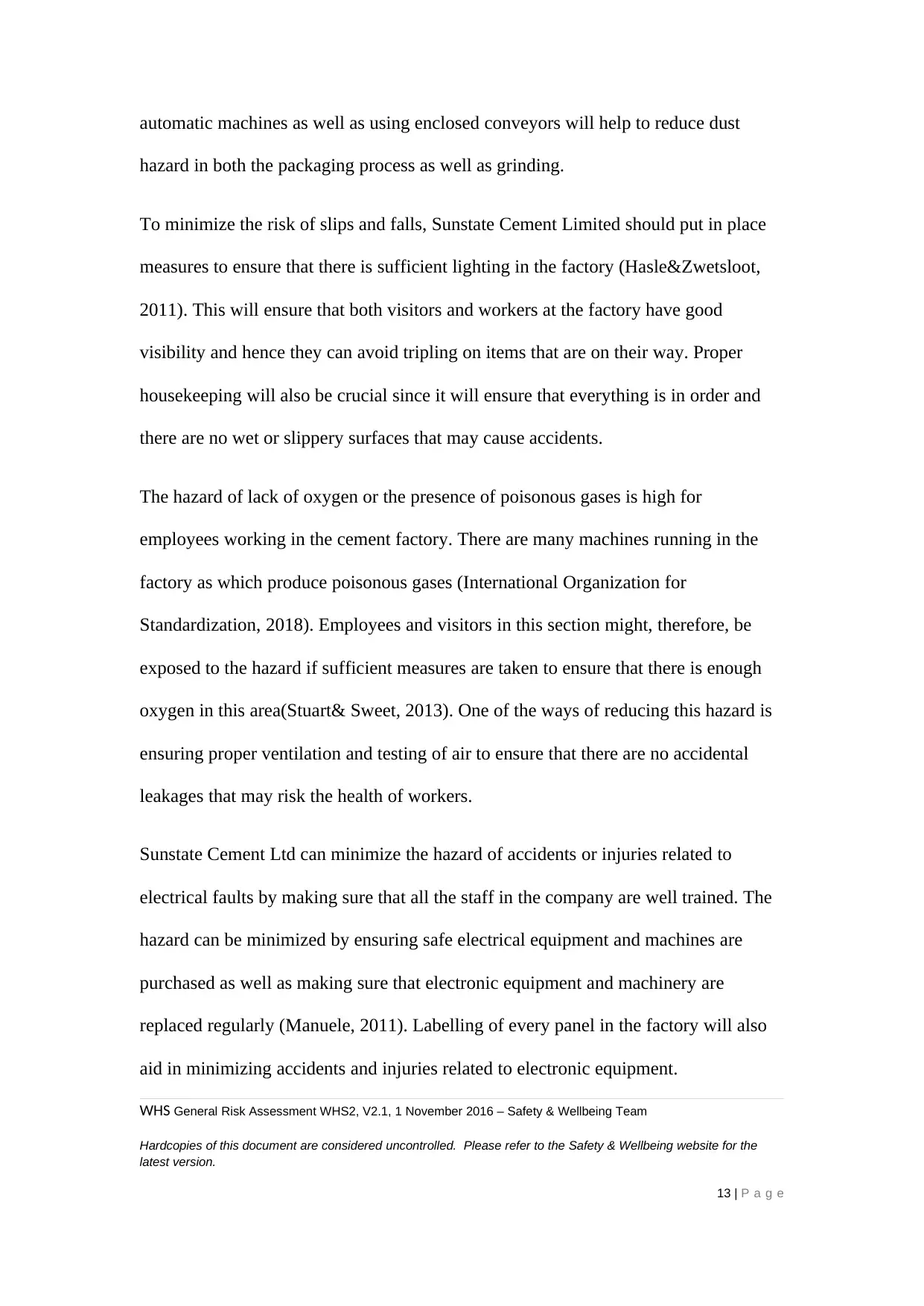
automatic machines as well as using enclosed conveyors will help to reduce dust
hazard in both the packaging process as well as grinding.
To minimize the risk of slips and falls, Sunstate Cement Limited should put in place
measures to ensure that there is sufficient lighting in the factory (Hasle&Zwetsloot,
2011). This will ensure that both visitors and workers at the factory have good
visibility and hence they can avoid tripling on items that are on their way. Proper
housekeeping will also be crucial since it will ensure that everything is in order and
there are no wet or slippery surfaces that may cause accidents.
The hazard of lack of oxygen or the presence of poisonous gases is high for
employees working in the cement factory. There are many machines running in the
factory as which produce poisonous gases (International Organization for
Standardization, 2018). Employees and visitors in this section might, therefore, be
exposed to the hazard if sufficient measures are taken to ensure that there is enough
oxygen in this area(Stuart& Sweet, 2013). One of the ways of reducing this hazard is
ensuring proper ventilation and testing of air to ensure that there are no accidental
leakages that may risk the health of workers.
Sunstate Cement Ltd can minimize the hazard of accidents or injuries related to
electrical faults by making sure that all the staff in the company are well trained. The
hazard can be minimized by ensuring safe electrical equipment and machines are
purchased as well as making sure that electronic equipment and machinery are
replaced regularly (Manuele, 2011). Labelling of every panel in the factory will also
aid in minimizing accidents and injuries related to electronic equipment.
WHS General Risk Assessment WHS2, V2.1, 1 November 2016 – Safety & Wellbeing Team
Hardcopies of this document are considered uncontrolled. Please refer to the Safety & Wellbeing website for the
latest version.
13 | P a g e
hazard in both the packaging process as well as grinding.
To minimize the risk of slips and falls, Sunstate Cement Limited should put in place
measures to ensure that there is sufficient lighting in the factory (Hasle&Zwetsloot,
2011). This will ensure that both visitors and workers at the factory have good
visibility and hence they can avoid tripling on items that are on their way. Proper
housekeeping will also be crucial since it will ensure that everything is in order and
there are no wet or slippery surfaces that may cause accidents.
The hazard of lack of oxygen or the presence of poisonous gases is high for
employees working in the cement factory. There are many machines running in the
factory as which produce poisonous gases (International Organization for
Standardization, 2018). Employees and visitors in this section might, therefore, be
exposed to the hazard if sufficient measures are taken to ensure that there is enough
oxygen in this area(Stuart& Sweet, 2013). One of the ways of reducing this hazard is
ensuring proper ventilation and testing of air to ensure that there are no accidental
leakages that may risk the health of workers.
Sunstate Cement Ltd can minimize the hazard of accidents or injuries related to
electrical faults by making sure that all the staff in the company are well trained. The
hazard can be minimized by ensuring safe electrical equipment and machines are
purchased as well as making sure that electronic equipment and machinery are
replaced regularly (Manuele, 2011). Labelling of every panel in the factory will also
aid in minimizing accidents and injuries related to electronic equipment.
WHS General Risk Assessment WHS2, V2.1, 1 November 2016 – Safety & Wellbeing Team
Hardcopies of this document are considered uncontrolled. Please refer to the Safety & Wellbeing website for the
latest version.
13 | P a g e
Paraphrase This Document
Need a fresh take? Get an instant paraphrase of this document with our AI Paraphraser
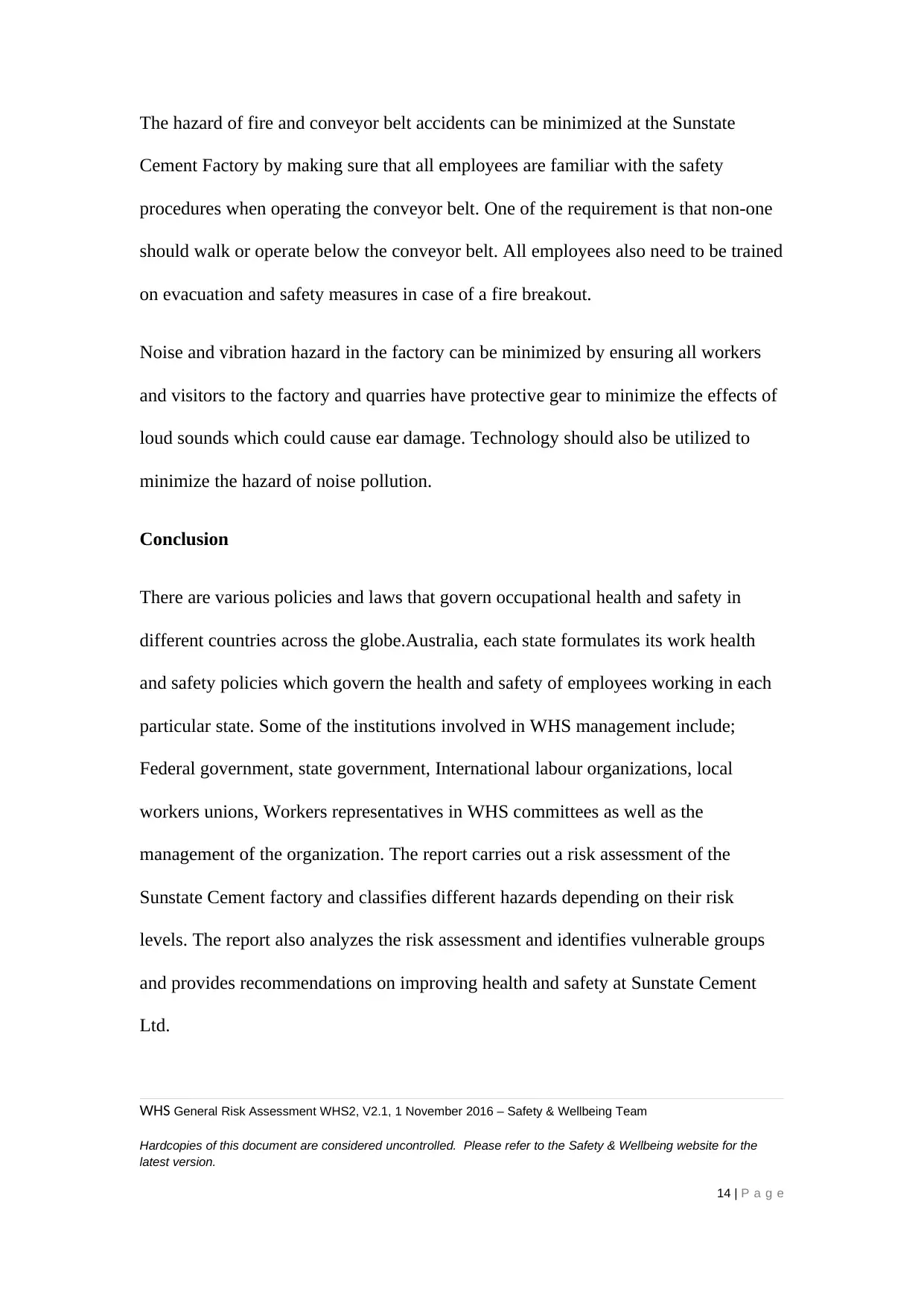
The hazard of fire and conveyor belt accidents can be minimized at the Sunstate
Cement Factory by making sure that all employees are familiar with the safety
procedures when operating the conveyor belt. One of the requirement is that non-one
should walk or operate below the conveyor belt. All employees also need to be trained
on evacuation and safety measures in case of a fire breakout.
Noise and vibration hazard in the factory can be minimized by ensuring all workers
and visitors to the factory and quarries have protective gear to minimize the effects of
loud sounds which could cause ear damage. Technology should also be utilized to
minimize the hazard of noise pollution.
Conclusion
There are various policies and laws that govern occupational health and safety in
different countries across the globe.Australia, each state formulates its work health
and safety policies which govern the health and safety of employees working in each
particular state. Some of the institutions involved in WHS management include;
Federal government, state government, International labour organizations, local
workers unions, Workers representatives in WHS committees as well as the
management of the organization. The report carries out a risk assessment of the
Sunstate Cement factory and classifies different hazards depending on their risk
levels. The report also analyzes the risk assessment and identifies vulnerable groups
and provides recommendations on improving health and safety at Sunstate Cement
Ltd.
WHS General Risk Assessment WHS2, V2.1, 1 November 2016 – Safety & Wellbeing Team
Hardcopies of this document are considered uncontrolled. Please refer to the Safety & Wellbeing website for the
latest version.
14 | P a g e
Cement Factory by making sure that all employees are familiar with the safety
procedures when operating the conveyor belt. One of the requirement is that non-one
should walk or operate below the conveyor belt. All employees also need to be trained
on evacuation and safety measures in case of a fire breakout.
Noise and vibration hazard in the factory can be minimized by ensuring all workers
and visitors to the factory and quarries have protective gear to minimize the effects of
loud sounds which could cause ear damage. Technology should also be utilized to
minimize the hazard of noise pollution.
Conclusion
There are various policies and laws that govern occupational health and safety in
different countries across the globe.Australia, each state formulates its work health
and safety policies which govern the health and safety of employees working in each
particular state. Some of the institutions involved in WHS management include;
Federal government, state government, International labour organizations, local
workers unions, Workers representatives in WHS committees as well as the
management of the organization. The report carries out a risk assessment of the
Sunstate Cement factory and classifies different hazards depending on their risk
levels. The report also analyzes the risk assessment and identifies vulnerable groups
and provides recommendations on improving health and safety at Sunstate Cement
Ltd.
WHS General Risk Assessment WHS2, V2.1, 1 November 2016 – Safety & Wellbeing Team
Hardcopies of this document are considered uncontrolled. Please refer to the Safety & Wellbeing website for the
latest version.
14 | P a g e
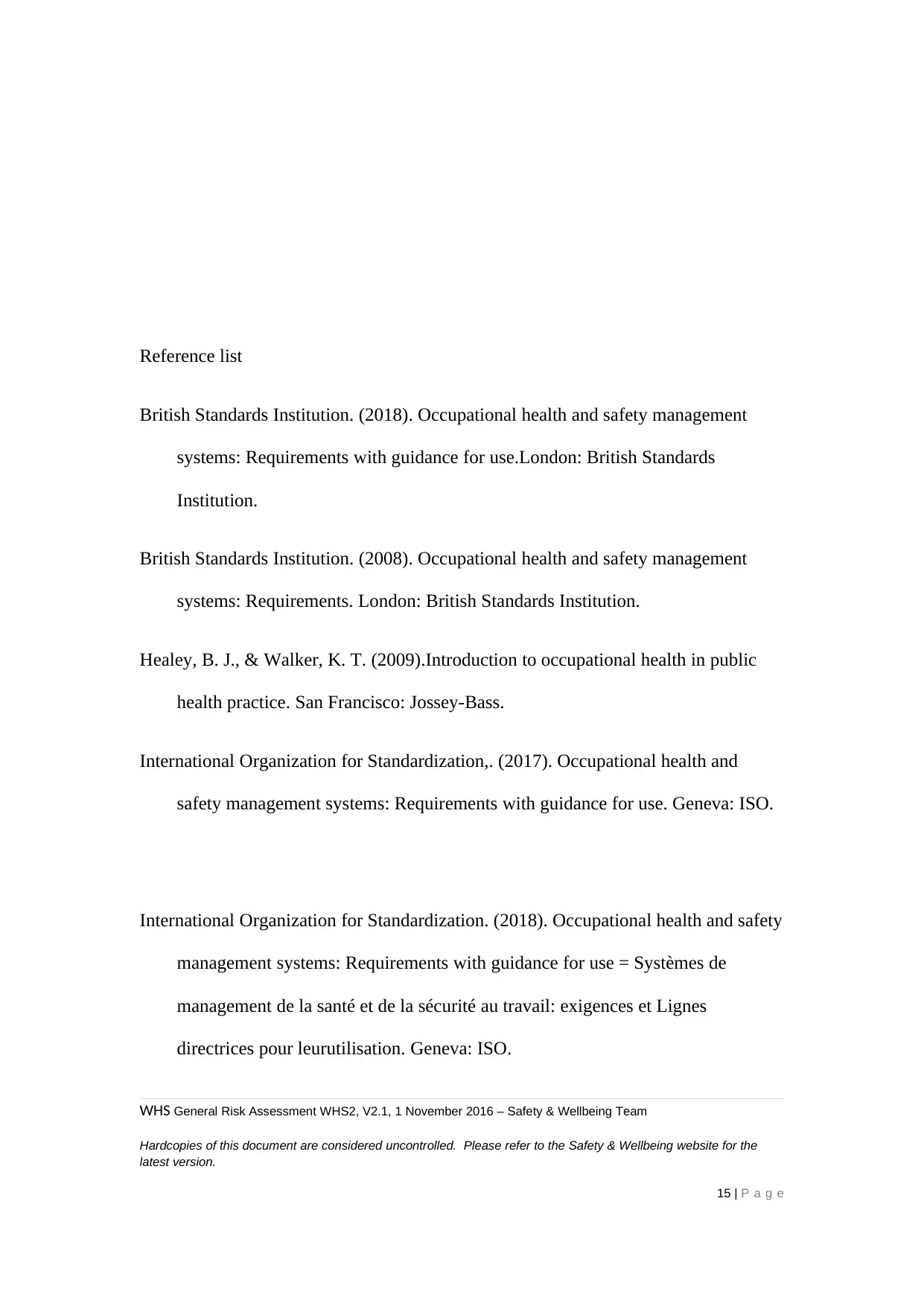
Reference list
British Standards Institution. (2018). Occupational health and safety management
systems: Requirements with guidance for use.London: British Standards
Institution.
British Standards Institution. (2008). Occupational health and safety management
systems: Requirements. London: British Standards Institution.
Healey, B. J., & Walker, K. T. (2009).Introduction to occupational health in public
health practice. San Francisco: Jossey-Bass.
International Organization for Standardization,. (2017). Occupational health and
safety management systems: Requirements with guidance for use. Geneva: ISO.
International Organization for Standardization. (2018). Occupational health and safety
management systems: Requirements with guidance for use = Systèmes de
management de la santé et de la sécurité au travail: exigences et Lignes
directrices pour leurutilisation. Geneva: ISO.
WHS General Risk Assessment WHS2, V2.1, 1 November 2016 – Safety & Wellbeing Team
Hardcopies of this document are considered uncontrolled. Please refer to the Safety & Wellbeing website for the
latest version.
15 | P a g e
British Standards Institution. (2018). Occupational health and safety management
systems: Requirements with guidance for use.London: British Standards
Institution.
British Standards Institution. (2008). Occupational health and safety management
systems: Requirements. London: British Standards Institution.
Healey, B. J., & Walker, K. T. (2009).Introduction to occupational health in public
health practice. San Francisco: Jossey-Bass.
International Organization for Standardization,. (2017). Occupational health and
safety management systems: Requirements with guidance for use. Geneva: ISO.
International Organization for Standardization. (2018). Occupational health and safety
management systems: Requirements with guidance for use = Systèmes de
management de la santé et de la sécurité au travail: exigences et Lignes
directrices pour leurutilisation. Geneva: ISO.
WHS General Risk Assessment WHS2, V2.1, 1 November 2016 – Safety & Wellbeing Team
Hardcopies of this document are considered uncontrolled. Please refer to the Safety & Wellbeing website for the
latest version.
15 | P a g e
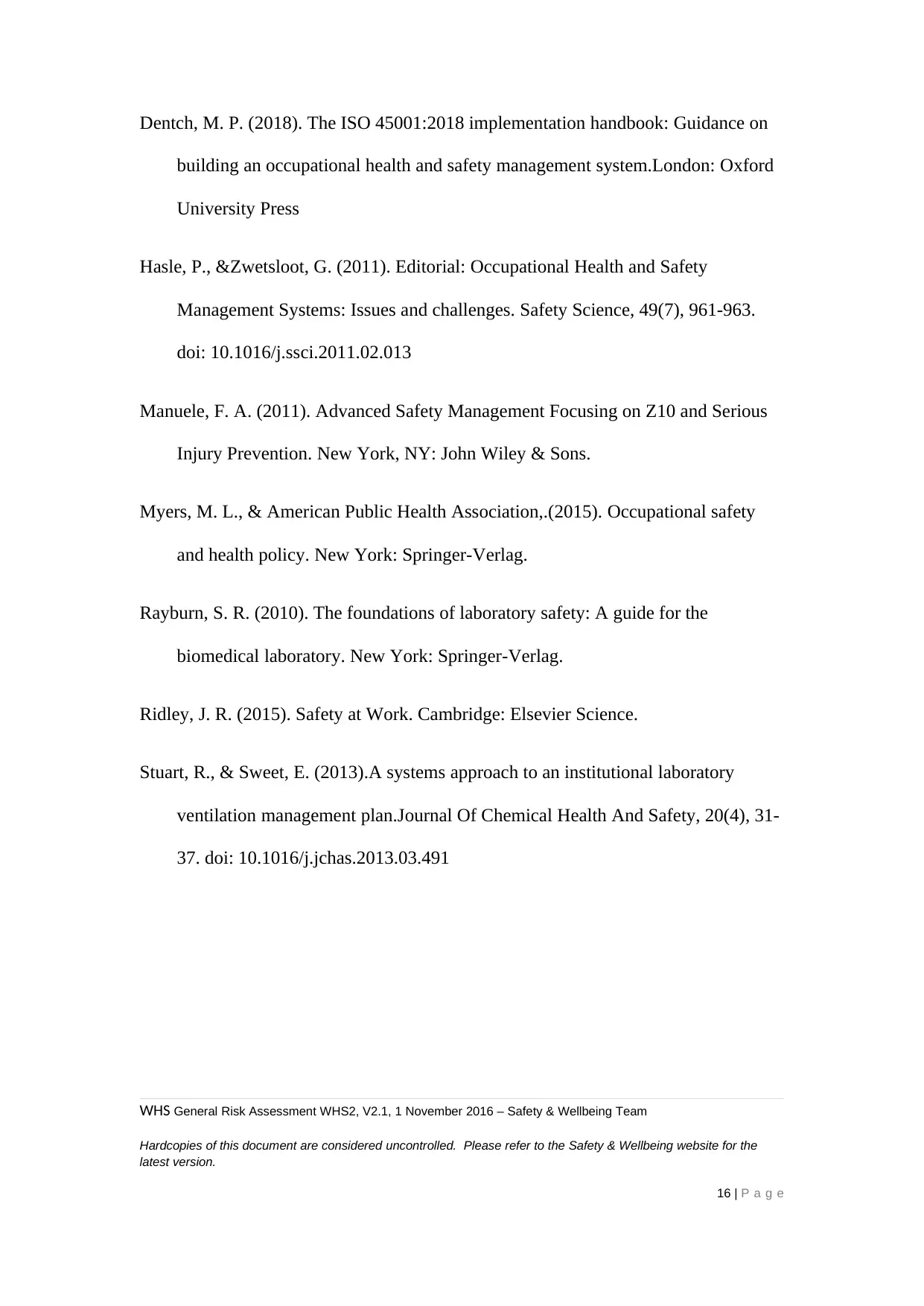
Dentch, M. P. (2018). The ISO 45001:2018 implementation handbook: Guidance on
building an occupational health and safety management system.London: Oxford
University Press
Hasle, P., &Zwetsloot, G. (2011). Editorial: Occupational Health and Safety
Management Systems: Issues and challenges. Safety Science, 49(7), 961-963.
doi: 10.1016/j.ssci.2011.02.013
Manuele, F. A. (2011). Advanced Safety Management Focusing on Z10 and Serious
Injury Prevention. New York, NY: John Wiley & Sons.
Myers, M. L., & American Public Health Association,.(2015). Occupational safety
and health policy. New York: Springer-Verlag.
Rayburn, S. R. (2010). The foundations of laboratory safety: A guide for the
biomedical laboratory. New York: Springer-Verlag.
Ridley, J. R. (2015). Safety at Work. Cambridge: Elsevier Science.
Stuart, R., & Sweet, E. (2013).A systems approach to an institutional laboratory
ventilation management plan.Journal Of Chemical Health And Safety, 20(4), 31-
37. doi: 10.1016/j.jchas.2013.03.491
WHS General Risk Assessment WHS2, V2.1, 1 November 2016 – Safety & Wellbeing Team
Hardcopies of this document are considered uncontrolled. Please refer to the Safety & Wellbeing website for the
latest version.
16 | P a g e
building an occupational health and safety management system.London: Oxford
University Press
Hasle, P., &Zwetsloot, G. (2011). Editorial: Occupational Health and Safety
Management Systems: Issues and challenges. Safety Science, 49(7), 961-963.
doi: 10.1016/j.ssci.2011.02.013
Manuele, F. A. (2011). Advanced Safety Management Focusing on Z10 and Serious
Injury Prevention. New York, NY: John Wiley & Sons.
Myers, M. L., & American Public Health Association,.(2015). Occupational safety
and health policy. New York: Springer-Verlag.
Rayburn, S. R. (2010). The foundations of laboratory safety: A guide for the
biomedical laboratory. New York: Springer-Verlag.
Ridley, J. R. (2015). Safety at Work. Cambridge: Elsevier Science.
Stuart, R., & Sweet, E. (2013).A systems approach to an institutional laboratory
ventilation management plan.Journal Of Chemical Health And Safety, 20(4), 31-
37. doi: 10.1016/j.jchas.2013.03.491
WHS General Risk Assessment WHS2, V2.1, 1 November 2016 – Safety & Wellbeing Team
Hardcopies of this document are considered uncontrolled. Please refer to the Safety & Wellbeing website for the
latest version.
16 | P a g e
1 out of 16
Related Documents
Your All-in-One AI-Powered Toolkit for Academic Success.
+13062052269
info@desklib.com
Available 24*7 on WhatsApp / Email
![[object Object]](/_next/static/media/star-bottom.7253800d.svg)
Unlock your academic potential
© 2024 | Zucol Services PVT LTD | All rights reserved.



